|
|
|
Sort Order |
|
|
|
Items / Page
|
|
|
|
|
|
|
| Srl | Item |
| 1 |
ID:
094763
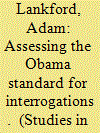

|
|
|
|
|
| Publication |
2010.
|
| Summary/Abstract |
On 22 January 2009, President Barack Obama issued an executive order that banned harsh interrogations and restricted legal methods to those listed in Army Field Manual 2-22.3. However, there remain concerns that the field manual may fail to prevent the continued abuse and torture of detainees. This study reexamines the leading social-psychological explanations for torture at Abu Ghraib to determine whether the manual appears sufficient to prevent future torture. Findings suggest that it has significantly curtailed future risks; however, in order to help ensure that U.S. soldiers' treatment of foreign detainees is consistently humane, additional steps should be taken.
|
|
|
|
|
|
|
|
|
|
|
|
|
|
|
|
| 2 |
ID:
054258
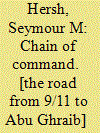

|
|
|
|
|
| Publication |
New York, Harper Collins Publishers, 2004.
|
| Description |
xix, 394p.Hbk
|
| Standard Number |
0060195916
|
|
|
|
|
|
|
|
|
|
|
|
Copies: C:1/I:0,R:0,Q:0
Circulation
| Accession# | Call# | Current Location | Status | Policy | Location |
| 048735 | 937.931/HER 048735 | Main | On Shelf | General | |
|
|
|
|
| 3 |
ID:
077355
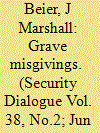

|
|
|
|
|
| Publication |
2007.
|
| Summary/Abstract |
Days after the December 1890 US Army massacre of Lakota refugees at Wounded Knee, South Dakota, commercial photographer George Trager photographed the Army burial detail as they cleared the site and committed the dead to a mass grave. Widely circulated as post-cards, Trager's photographs merged with a broader colonial narrative, allegorically and cathartically sketching a heroic account of a dire confrontation between `civilization' and `savagery'. Reconfirming dominant ideas about an inherently dangerous foe, the Wounded Knee photos worked through colonial imaginaries in ways that reinforced a Euro-American monopoly on legitimacy in war. More recently, widely circulated photos of abuse of prisoners by US soldiers at Baghdad's Abu Ghraib Prison have effected a disruption of the operant war narrative. Whereas Trager's photographs worked to sustain stable definitions of moral `civilization' and `savage' depravity, those from Abu Ghraib have undermined the legitimacy of US conduct in Iraq. In this article, I consider these differing effects with reference to photographic composition and the popular functions of allegory and catharsis
|
|
|
|
|
|
|
|
|
|
|
|
|
|
|
|
| 4 |
ID:
139578
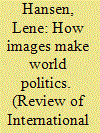

|
|
|
|
|
| Summary/Abstract |
This article introduces international icons to the field of International Relations. International icons are freestanding images that are widely circulated, recognised, and emotionally responded to. International icons come in the form of foreign policy icons familiar to a specific domestic audience, regional icons, and global icons. Icons do not speak foreign policy in and of themselves rather their meaning is constituted in discourse. Images rise to the status of international icons in part through images that appropriate the icon itself, either in full or through inserting parts of the icon into new images. Appropriations might be used and read as critical interventions into foreign policy debates, but such readings should themselves be subjected to analysis. A three-tier analytical and methodological framework for studying international icons is presented and applied in a case study of the hooded prisoner widely claimed to be emblematic of the Abu Ghraib prison scandal.
|
|
|
|
|
|
|
|
|
|
|
|
|
|
|
|
| 5 |
ID:
082747
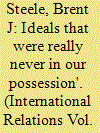

|
|
|
|
|
| Publication |
2008.
|
| Summary/Abstract |
This article addresses how the recent US treatment of suspects detained in its War on Terror relates to the issues of US self-identity and US honor. Both the abuse of these individuals, and the shock which such abuse engenders (when revealed to the US public), are manifested by punishment drives that reinforce a nation's sense of internal honor, which is constructed and connected to a nation's self-identity. While professing commitments to human rights, on the one hand, and interrogation and torture, on the other, are contradictory practices - they are similar in the sense that both are forms of discipline which uphold internally constituted ontological visions of the US Self. Drawing upon a Foucauldian view of ethics, `the relation to oneself', the article avers that precisely because these disciplinary mechanisms are driven by self-identity and protecting the `honor' of the US nation-state, domestic and international actors can use two tactics - `reflexive discourse' and self-interrogative imaging - to stimulate US agents to reform such practices in the future
|
|
|
|
|
|
|
|
|
|
|
|
|
|
|
|
| 6 |
ID:
143046
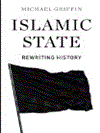

|
|
|
|
|
| Publication |
London, Pluto Press, 2016.
|
| Description |
xxiii, 176p.pbk
|
| Standard Number |
9780745336510
|
|
|
|
|
|
|
|
|
|
|
|
Copies: C:1/I:0,R:0,Q:0
Circulation
| Accession# | Call# | Current Location | Status | Policy | Location |
| 058434 | 320.10917671/GRI 058434 | Main | On Shelf | General | |
|
|
|
|
| 7 |
ID:
124235


|
|
|
|
|
| Publication |
2013.
|
| Summary/Abstract |
A decade ago, in the autumn of 2003, a small group of soldiers criminally abused detainees at the Abu Ghraib prison in Iraq. Two divergent narratives explaining these events emerged: a "bad apple" narrative and a "bad barrel" narrative. Neither does justice to the complex interplay of policy, organizational, and individual factors that contributed to these tragic events. A perfect storm of poor leadership, chaotic and confusing policy changes, and a small group of corrupt and immoral soldiers produced this fiasco with global consequences
|
|
|
|
|
|
|
|
|
|
|
|
|
|
|
|
| 8 |
ID:
091960
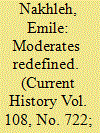

|
|
|
|
|
| Publication |
2009.
|
| Summary/Abstract |
Political Islam has been part of the modern Middle East landscape for several decades, but until recently the United States has rarely perceived a need to engage it. After the attacks against New York and Washington on September 11, 2001, the administration of George W. Bush painted political Islam in the Middle East, as in the rest of the Muslim world, with the broad brush of terrorism.
|
|
|
|
|
|
|
|
|
|
|
|
|
|
|
|
| 9 |
ID:
157563


|
|
|
| 10 |
ID:
092188
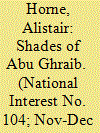

|
|
|
| 11 |
ID:
091946
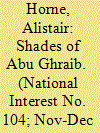

|
|
|
| 12 |
ID:
103113
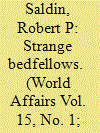

|
|
|
| 13 |
ID:
109549
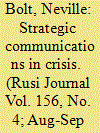

|
|
|
| 14 |
ID:
090167
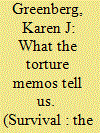

|
|
|
|
|
| Publication |
2009.
|
| Summary/Abstract |
On 16 April 2009, US President Barack Obama, responding to an American Civil Liberties Union (ACLU) Freedom of Information Act request, released four Bush-era documents belonging to a series of papers known collectively as the 'torture memos', which outline the US government's legal analysis and policy decisions for interrogating terrorism suspects in the wake of the 11 September 2001 attacks. In the years since the release of the Abu Ghraib photographs and the subsequent reports into detention and interrogation policies in the 'war on terror', the public has been made generally aware of the content of these papers. Beginning in summer 2004, we have been able to read many of the major documents, including the infamous memo of 1 August 2002 that redefines torture; the Alberto Gonzales memo of 25 January 2002 that called the Geneva Conventions 'quaint and obsolete'; and Donald Rumsfeld's letter signing off on the enhanced interrogation techniques that would create a law-free zone at Guantanamo Bayfor six weeks from early December 2002 until January 2003. All of these have been subjected time and again to the scrutiny of scholars and experts such as Philippe Sands, Mark Danner and others, as well as to the attention of congressional oversight committees.
|
|
|
|
|
|
|
|
|
|
|
|
|
|
|
|
| 15 |
ID:
111184
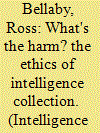

|
|
|
|
|
| Publication |
2012.
|
| Summary/Abstract |
As the professional practice of intelligence collection adapts to the changing environment and new threats of the twenty-first century, many academic experts and intelligence professionals call for a coherent ethical framework that outlines exactly when, by what means and to what ends intelligence is justified. Reports of abuse at detention centres such as Guantanamo Bay and Abu Ghraib, the ever increasing use of technological surveillance, and the increased attention on the use of torture for intelligence collection purposes have all highlighted a need to make an explicit statement about what is and what is not permissible intelligence practice. In this article an ethical framework will be established which will outline under what circumstances the use of different intelligence collection activities would be permissible. This ethical framework will first underline what it is about intelligence collection that is 'harmful' and, therefore, should be prohibited under normal circumstances. The ethical framework then outlines a set of 'just intelligence principles', based on the just war tradition, which delineate when the harm caused can be justified. As a result, this article outlines a systemic ethical framework that makes it possible to understand when intelligence collection is prohibited and when it is permissible.
|
|
|
|
|
|
|
|
|
|
|
|
|
|
|
|
|
|
|
|
|